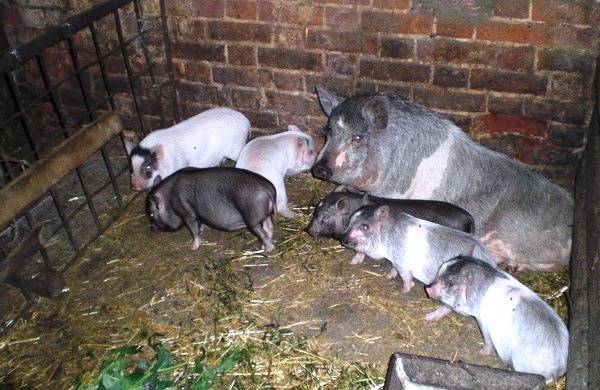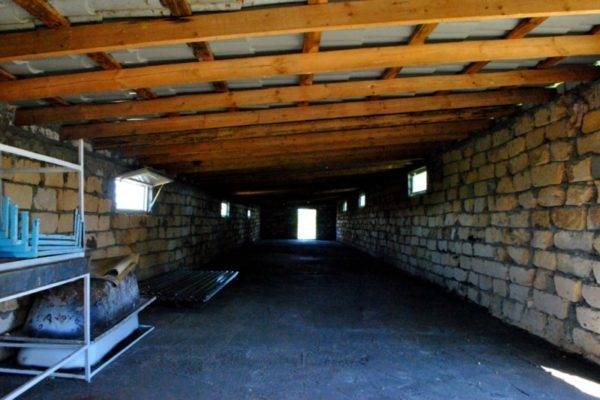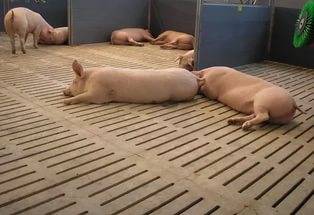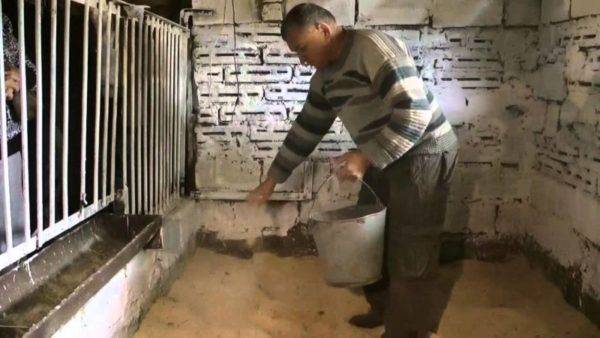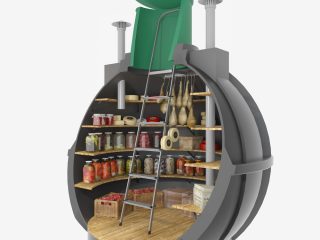Content
If the owner of a private plot plans to raise pigs and chickens, he needs a well-equipped barn. A temporary building will not be suitable for these purposes, because a favorable microclimate and comfortable conditions must be created in the room even in winter. However, you can save some money here. Build chicken barn and pigs can be one in common. You just need to properly plan and equip it inside. Now we will try to find answers to the question of how to build a barn for pigs with our own hands, and set aside a corner in it for keeping chickens.
What you need to know about the pigsty
Setting up a barn for pigs is much more complex than setting up a barn just for chickens. First of all, you need a reliable floor, since these animals love to dig with their snouts. Moreover, just a flat surface will not work. It is necessary to provide gutters through which waste will be drained, and there will be a lot of them.
Pig manure produces a lot of ammonia vapor. It is impossible to get rid of it without supply and exhaust ventilation.Exhaust ducts need to be planned at the stage of developing the pigsty project.
Now let's determine the size of the shed. Here you must immediately take into account that the plan depends entirely on the expenses that the owner can incur. Chickens don’t need a lot of space, although it all depends on the breed. On average 1 m2 You can keep two adult birds. But with pigs the question is more complicated, since they need a more spacious barn. Even the layout of the barn depends on the purpose for which you will raise pigs. For example, if you plan to keep a sow with young animals, then the pens need to be made of different types with different sizes of free space.
When calculating the size of the pen, they rely on the following requirements:
- For a young pig without offspring, 2 m are allocated2 area. If the design of the pigsty allows 2.5 m to be allocated for the pig2, then this will only be beneficial.
- The pen for the sow and piglets is spacious. They are given an area of at least 5 m2.
- If a boar is supposed to be kept for breeding offspring, then the size of its pen will be approximately the same as that of a sow.
The walls of the pen must be at least one and a half meters high, otherwise the pigs will be able to jump over them. If it is planned to make stalls in two rows, then a passage at least 1.5 m wide is provided between them.
The layout of the pigsty must be made in such a way that it is convenient to remove manure. It is important to provide water supply and artificial heating of the barn for the winter. To avoid high heating costs, the pigsty must be insulated.
When drawing up a barn project, it is necessary to correctly calculate the size of the windows, and not their number. The sum of their area should not exceed the floor area. If a lot of light gets into the barn, the pigs will become irritable.If the yard area allows for the construction of additional buildings, then you need to make a summer paddock. Here the pigs will walk during the day and enter the barn only at night.
Building a pigsty on your own
So, we have dealt with the requirements, now we will look at how to make a barn for pigs and chickens on your site. To build a good barn, you need to develop a project, the basis of which is an accurate drawing of the building. In the photo we show an example of the diagram of a pigsty and its internal layout.
The barn is designed to house young animals, boars and sows. If you intend to build a small pigsty only for raising piglets for fattening, then you will have to build another drawing with individually calculated dimensions.
Laying the foundation of a barn for pigs and chickens
Construction of a barn for pigs and chickens begins with laying the foundation. The construction will be major, so it needs a reliable foundation. It is optimal to pour a strip foundation under the pigsty. Its design is not complicated, as the diagram in the photo confirms, but it will require a lot of work.
Work begins with marking the territory, after which they dig a trench about 800 mm deep. The width should be several centimeters greater than the thickness of the walls.Formwork is installed around the trench, a sand cushion 150–200 mm thick is poured, the bottom and walls are covered with roofing felt, after which concrete is poured.
Construction of the barn walls begins no earlier than two weeks later. During this time, the concrete will gain strength.
Construction of pigsty walls
Reliable pigsty walls will be made of cinder block, brick or rubble stone. Farms can build sheds from reinforced concrete slabs. For a small household, you can build a barn from boards and timber.
It doesn’t matter what material was chosen, but the walls of the pigsty must retain heat inside the room. To do this, they are insulated with foam plastic or mineral wool. This can be done from the inside or outside. The first method is not very effective, since a lot of free space in the shed is taken up with increasing wall thickness.
Windows are placed at a height of 1.5 m from the floor. At least most of them need to be equipped with hinges. The barn is ventilated through opening windows.
We arrange the roof and ceiling of the pigsty
Optimal height of home pigsty is 2 m. This allows you to conveniently clean the barn, as well as heat it faster in winter. A ceiling in a pigsty is required. It is very convenient to use reinforced concrete floor slabs when building such sheds. They simultaneously act as a ceiling and a roof.
If there are no slabs, then the ceiling is lined with boards to the floor beams. The top is insulated with mineral wool or polystyrene foam. You can use natural materials: sawdust, straw, hay. It is better to make the roof of the pigsty single-pitched. This way, less heat will escape through the attic.If you decide to build a gable roof, you need to be prepared for additional costs. In addition to the ceiling, you will also have to insulate the roof, plus construct a complex rafter system.
Arrangement of the floor in the barn
The floor in the barn must be done correctly, otherwise cleaning up the manure will become more difficult and the pigs will always be dirty. The type of flooring depends on the choice of material. If wood is chosen, then the floor is made in the form of a podium. The timber logs are laid at a height of 100 mm from the ground, after which a 50 mm thick board is sewn on.
A concrete floor in a pigsty is considered the most reliable, but it is better to make it a combined floor. Pigs, and especially sows, need warmth. Where they will sleep, a section of the floor is covered with boards, and the rest of the area is concreted.
The design of any floor should have a slope to facilitate waste collection. Slotted floors are practiced on farms. To do this, reinforced concrete gratings are laid on the concrete floor. Through the cracks, waste falls onto the lower floor, where it is discharged into specially equipped channels. However, for a home pigsty such technology will be expensive.
Interior arrangement of the barn
So, the barn has already been built, now let's look at how to properly arrange it inside. The only finishing work envisaged is whitewashing the entire room with lime. Next, they begin to form pens and install feeders.
Installation of partitions and feeders
To make a pen for pigs, you need to install partitions inside the barn.Durable material is used to make them. Most often, steel gratings are welded from a pipe, profile and angle. As an option, you can get strong cinder block partitions. You can pour monolithic concrete walls. There are many options. It all depends on the owner’s budget. As a last resort, pens can be fenced with wooden partitions, but their service life is limited to several seasons.
The summer pen for pigs is a fenced area near the barn. It is equipped on the side of the front door. The simplest option for a corral is metal or concrete poles driven into the ground. A steel mesh is stretched between the posts. Moreover, it needs to be dug in from below, otherwise the pigs will dig under it and crawl out of the pen.
Feeders are placed in such a way as to provide easy access for pigs and humans for maintenance. Bunker-type designs are very popular, allowing for rational use of feed.
Pig barn ventilation
The waste releases many harmful fumes, especially ammonia. If they are not removed from the barn, the pigs will begin to get sick. Some of the fumes can be removed by ventilation, but in winter a lot of heat will escape through open windows and doors. In addition, there is a draft inside the barn, which causes colds in the pigs.
The problem can only be solved by arranging ventilation for the barn. In a large pigsty, it is optimal to install an industrial forced-type ventilation system. All fumes will be drawn out by electric fans. In a small home pigsty, a homemade supply and exhaust ventilation system consisting of two pipes is installed.
Heating and lighting
Pigs themselves produce heat, but in cold winter it may not be enough. The temperature inside the barn during the most severe frosts should not fall below +5OC. It is optimal to maintain it within 13–22OC. In the pen with the sow it must be at least +28OC. To maintain this temperature, potbelly stoves or electric heaters are installed inside the barn.
You definitely need to take care of artificial lighting. Lamps are hung in protective shades so that pigs cannot reach them.
The video shows a pigsty:
Conclusion
That's all the secrets of building a barn for keeping pigs. If chickens will live with the pigs, a corner will be set aside for them inside the pigsty. There you need to install feeders, perches and nests. It is important to ensure the safety of the bird by installing a mesh partition so that it does not get to the pigs, otherwise they may tear the chicken apart.
